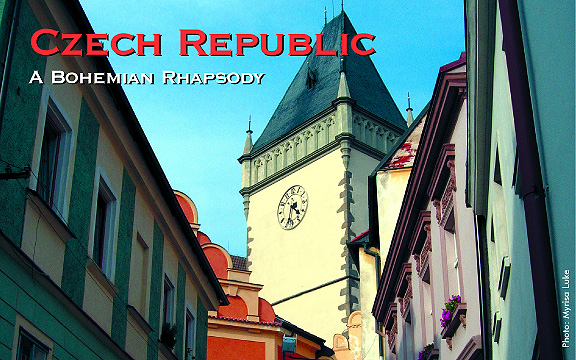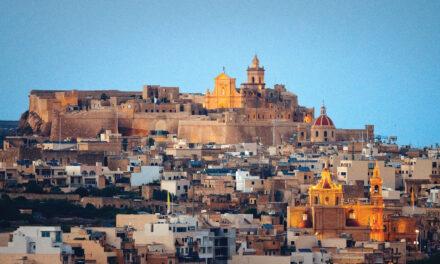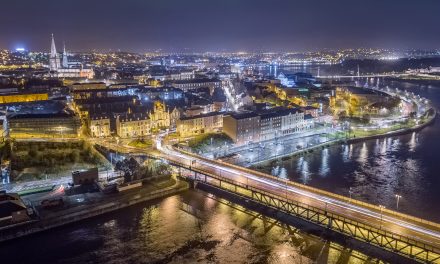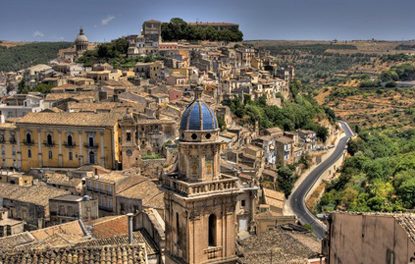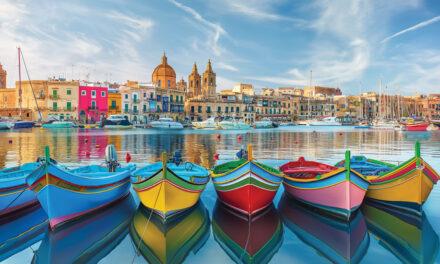Czech Republic
A Bohemian Rhapsody
Published in the Winter 2008-09 Issue of Canadian World Traveller
By Greg James (greg@canadianworldtraveller.com)
Photos by Myrisa Luke and others
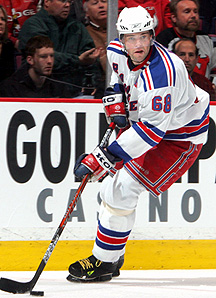 On my arrival at Prague’s Ruzyne International Airport, I took a taxi to my hotel. As we got on our way, the driver asked me where I was from. The instant I replied “Canada,” his eyes lit up! He knew right there and then that we had something in common. Hockey!
On my arrival at Prague’s Ruzyne International Airport, I took a taxi to my hotel. As we got on our way, the driver asked me where I was from. The instant I replied “Canada,” his eyes lit up! He knew right there and then that we had something in common. Hockey!
The Czechs are just as mad about hockey as Canadians are. His big hero of course was Czech hockey superstar Jaromir Jagr who played for the New York Rangers until he was snapped up by the Russian Omsk team.
My knowledge of Czech players was limited, but I did know that two of the opening games of the NHL’s 2008-2009 season would be played in Prague for the very first time and that local fans had bought out the games the minute the pricey tickets went on sale.
I found it amusing that I had brushed up on my knowledge of the Czech capital and the historic Southern Bohemian towns I would visit, whilst instead, I should have been reading the sports pages!
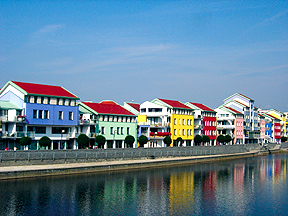 Golden Sands of Pisek
Golden Sands of Pisek
After spending a comfortable night in Prague at the brand-new five-star Clarion Congress Hotel Prague, we left the following morning on the short 105-km southbound drive to the medieval town of Pisek.
We met our local guide on the oldest stone bridge still standing in all of Bohemia. It was probably built around 1300 and spans the winding Otava River, which runs through the town.
Pisek, which means ‘sand’, got its name because of the rich deposits of gold panned from the sands along the riverbanks. For that very reason it was designated as a Royal Town back in medieval times.
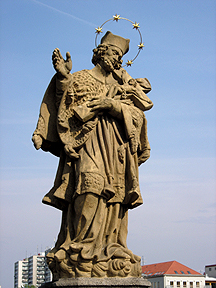 Near Disastrous Flood
Near Disastrous Flood
As we crossed the bridge on foot, our local guide recalled the record 2002 flood when rushing rising waters actually covered the stone bridge and damaged some of the statues that adorn it.
However, the town has now restored most of the statues along with the other casualties of the flood.
One controversy was the reconstruction of the houses along the historic river bank dubbed the ‘New Town’, which features modern brightly-coloured facades.
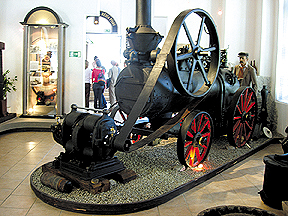
Let There Be Light!
On the other side of the river, we visited the oldest water power station in Bohemia.
On June 23, 1887, electric engineer Frantisek Krizik threw the switch to magically light up two street lamps in the centre of Pisek.
Today, part of the little power station is a museum displaying 100-year-old machines. In an adjoining room, some of them were amazingly still working away and causing quite a din.
We concluded our visit of Pisek by raising a glass of bubbly in the courtyard of the Malt House, which used to be part of a historic brewery but was recently restored to be an interactive activity centre for all ages.
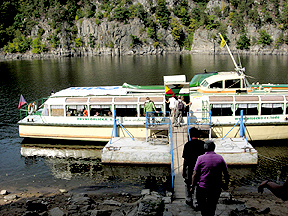
Orlik Lake Boat Ride
Our lunch at Hotel Zvikov, located in the lake district of Zvikovske Pohradi, featured perfectly seasoned and grilled trout on its extensive menu.
The fish was caught that very morning in Orlik Lake, which we could view from the hotel’s spacious dining room.
After lunch, we embarked on a short sightseeing boat tour on Orlik Lake, which was artificially created when a dam was constructed near the confluence of the Otava and Vltava Rivers.
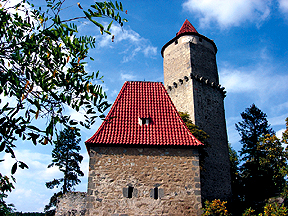 Our boat tour began from a dock located below Zvikov Castle and took us under the Zvikov and Zdakov Bridges and past Orlik Castle. Refreshments were provided, including quaffs of the Czech Republic’s original pilsner beer.
Our boat tour began from a dock located below Zvikov Castle and took us under the Zvikov and Zdakov Bridges and past Orlik Castle. Refreshments were provided, including quaffs of the Czech Republic’s original pilsner beer.
As the boat slowly encircled the lake on its return to the dock, I couldn’t help thinking that, without the historic towering castles on the shores, I could very well be sailing on a similar lake in Canada!
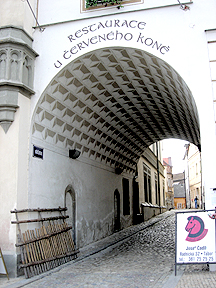
Tabor: Hussite Traditions
Tabor is just 83 km south of the Prague. With a population of 37,000, it is the second largest town in Southern Bohemia. But I was about to discover that this town has a rather unique history, which sets it apart from other Czech communities.
Tabor, a Biblical name, was founded in 1420 by followers of Jan Hus, the religious thinker, philosopher and would-be-reformer of the Catholic Church.
Hus was born in Bohemia around 1372 and after a life of challenging church orthodoxy was burned to death as a heretic in 1415 for his beliefs.
In 1437, after a period of protracted struggles, the Hussites of Tabor were finally defeated, but their spirit lived on in the form of the Protestant Reformation Movement that spread across Europe.
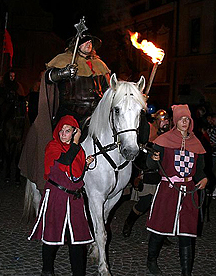 On our brief visit to Tabor, I was particularly taken with the unique features of the exterior walls of the buildings in the town’s main square.
On our brief visit to Tabor, I was particularly taken with the unique features of the exterior walls of the buildings in the town’s main square.
This 13th-century technique of exterior wall décor is called Sgraffito (“scratched”). It was produced by applying layers of plaster tinted in contrasting colors then scratching the surface to produce a stunning, almost ‘modern’ three-dimensional graphic design.
Tabor Meetings
In mid-September, Tabor holds its great annual international festival ‘Tabor Meetings‘ three-day festival that includes performances by hundreds of actors, musicians and ordinary citizens dressed in authentic recreations of medieval garb, all celebrating the town’s great Hussite past. This spectacle is a must-see if you’re ever in the Czech Republic at that time of year.
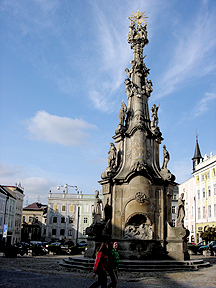
Medieval Jindrichuv Hradec
We travelled from Prague to Jindrichuv Hradec located about156 km southeast of the capital and checked into the modest but comfortable Hotel Concertino located near the town square, where an elaborate 18th-century monument in memory of the plague stands imposingly at its centre.
Our plan was to partake in an evening of medieval festivities at the town’s magnificent State Castle and Palace, which is the third largest complex of its kind in the Czech Republic after Prague Castle and the palace in Cesky Krumlov.
For over seven centuries, generations of aristocratic families lived here beginning with the lords of Hradec in 1220, hence the town’s name.
As one would imagine, the monumental buildings surrounding three huge courtyards have undergone many changes over the long history of the complex, resulting in a mélange of architectural styles.
Black Kitchen
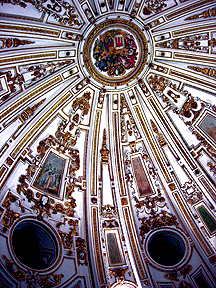 We walked from our hotel to the palace by way of a cobble-stoned, slightly inclined street and began our visit in the so-called ‘black’ kitchen restored to its original medieval state, including effigies of the type of animals, fowl and fish that would have been on the menu of the day.
We walked from our hotel to the palace by way of a cobble-stoned, slightly inclined street and began our visit in the so-called ‘black’ kitchen restored to its original medieval state, including effigies of the type of animals, fowl and fish that would have been on the menu of the day.
The walls and ceiling were covered in layers of black soot from the years of cooking on open fires, hence the name. I was happy to discover that our medieval-style dinner would not be prepared here!
Renaissance Rondelle
After the meal, we moved to the beautiful ‘Rondelle’, a one-storey circular renaissance structure with an elaborately decorated domed ceiling, to see three beautifully costumed couples perform a program of elegant dances from medieval times. They even invited us to join in at the end of the evening!
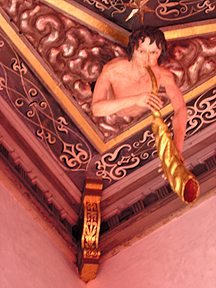
Telc: World Heritage Site
On our way to visit the UNESCO World Heritage Site of Telc, our guide gave us the correct pronunciation of the town’s name, which sounds like ‘Telsh’ rhyming with Welsh. Though having just 6000 inhabitants, this attractive little town that dates back to the 1300s, welcomes thousands of international tourists each year.
The main attraction is its 16th-century, Renaissance-style Château. I was truly amazed at the three-dimensional figures, representing mythical characters and creatures of all kinds, which sprouted out from the high, brightly-painted and gilded ceilings of its elegant rooms.
The Château’s displays of medieval armour and weaponry and its picture galleries featuring portraits of its past residing nobility were equally impressive.
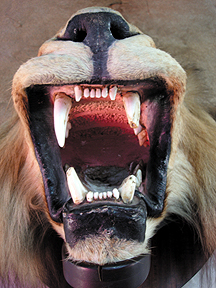 Wild Collection
Wild Collection
What was totally unexpected and rather startling was the trophy room of one of the previous owners of the Château who was an avid explorer and huntsman.
The walls of this gallery were covered from floor to ceiling with the stuffed and mounted heads and quite a few whole carcasses of wild animals and reptiles from Africa and other exotic locations! Of course, such an activity would not be condoned today.
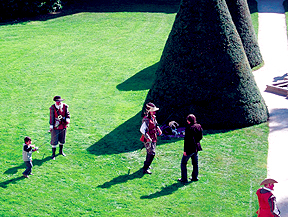
Château Musketeers
As we walked along the open exterior corridors of the Château we could see several costumed swordsmen play-fighting on the perfectly manicured lawns below, much to the enchantment of the scores of onlookers.
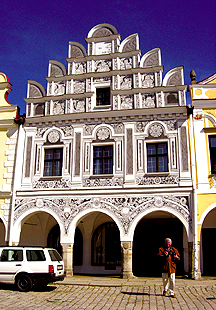
An Elegant Square
Laid out like a broad avenue but also having the feeling of an elegant square, the main thoroughfare of Telc is lined with rows of houses of ordinary residents. Small shops and boutiques lined their ground-floor arcades.
What made these buildings different were their individually decorated gabbled fronts, which were painted in unexpected bright pastel shades. These Renaissance and Baroque-style fronts (some decorated with Sgraffito designs) were later additions to the original Gothic-style houses. The well-preserved beautiful facades contributed to Telc’s UNESCO designation!
At the top of the square we stopped in at Restaurant Pod vezi where I had a hearty perfectly grilled steak with all the trimmings and a nice cold glass of Czech Pilsner beer in the establishment’s cozy dining room.
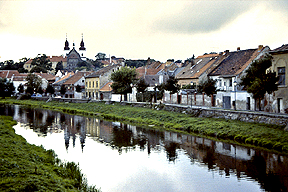
Old Jewish Quarter of Trebic
We made a short stop at the town of Trebic, which lies on the banks of the Jihlava River in Moravia, the southeastern territory of the Czech Republic.
Trebíc is home to one of the best-preserved and most extensive old Jewish Quarters in Europe. The Quarter is a UNESCO protected site.
I must admit that It was a bit eerie walking past the remaining 123 houses and entering the two synagogues knowing that this was a thriving community before the Second World War.
Many of the expelled Czech Jews became victims of the holocaust. After the war, only a handful of survivors returned to Trebic and according to the guide in the synagogue we visited, the last of them, an elderly woman, had sadly passed away just a few years prior to our visit.
However, it’s wonderful that at least with the preservation and protection of the Quarter, the former Jewish community of Trebic will never be forgotten.
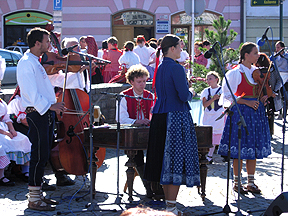 Trebic Folk Festival
Trebic Folk Festival
On a lighter note, we happened to be in Trebic the very same day that the town was celebrating its annual folk festival in its main square.
Several traditional musical and dance troupes were performing on the open-air stage and there were many colourful stalls offering local handicrafts and lots of goodies to eat and drink.
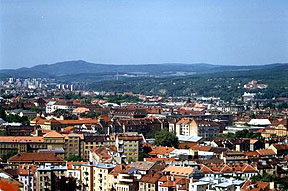
Brno: Moravia Metropolis
On our arrival in Brno, we checked in at Hotel Bobycentrum. With a population of almost 370,000 inhabitants, Brno is the Czech Republic’s second largest city.
Brno is also the metropolis of Moravia, the Czech Republic’s southeastern territory, and although I didn’t get to see much of it I could feel the pulse of this dynamic city, which combines historic sites with modern buildings and facilities. Much as I love the countryside, I’m an urbanite at heart.
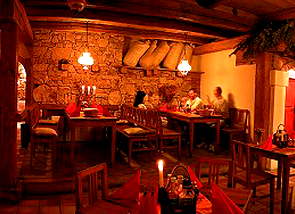 That evening, we dined at the Restaurant Nebesky Mlyn, which is located in a converted old mill.
That evening, we dined at the Restaurant Nebesky Mlyn, which is located in a converted old mill.
The giant water wheel is now a part of the charmingly rustic décor.
Its buffet style dinner, featuring all sorts of Czech delicacies, was great and the wine tasting of local reds and whites was a very nice unexpected touch, but the real high point of the evening was the live entertainment.
Swinging Moravian Band
It’s said that Moravian traditional music is really where East meets West. The minute the five-member band started playing, I knew that was true. The infectious strains and toe-tapping rhythms produced so enthusiastically by the band soon had the whole room going.
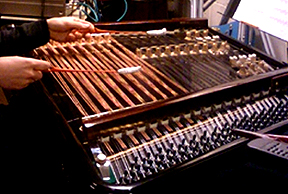 There were the familiar instruments like the two violins, clarinet and double bass. But then there was that strange instrument that created a truly unique sound.
There were the familiar instruments like the two violins, clarinet and double bass. But then there was that strange instrument that created a truly unique sound.
I later found out that it’s called a ‘cimbalom‘ and it’s made up of many strings mounted on a flat horizontal board.
With very few breaks, the tireless band members kept us entertained us for the entire evening.
Bar & Bowling Alley
On returning to the Hotel Bobycentrum, a few of us decided to have a nightcap in the hotel bar only to discover that one of the hotel’s facilities was a bowling alley adjacent to the bar! Some decided to bowl, others to drink and some did both with hilarious results.
Brno’s Tugendhat Villa
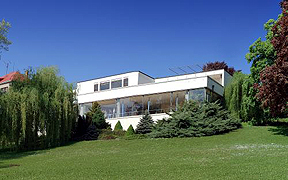 Brno’s world-famous Tugendhat Villa is one of the city’s star attractions.
Brno’s world-famous Tugendhat Villa is one of the city’s star attractions.
The villa, designed by Mies van der Rohe in 1929, is widely considered to be one of the most important milestones in the history of 20th-century architecture.
In 2001, it became one of the very few modern structures to be recognized as a UNESCO World Cultural Heritage Site. And justly so!
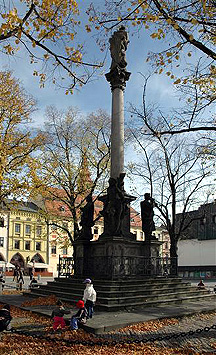
Jihlava: Royal Silver Town
Located off the main road between Prague and Brno, the town of Jihlava is easy to reach by car from either of the cities. Jihlava lies on the banks of the river of the same name.
In the 13th century, silver deposits were discovered here, leading to Jihlava being declared a Silver Town. And the rest, as they say, is history.
A Town Hall That Grew
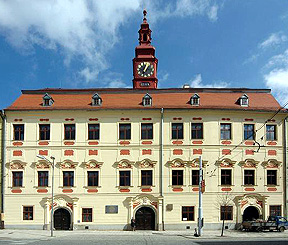 The historic Town Hall that stands on Jihlava’s main Square began in 1425 as a converted private residence that was the home of one Nicholas Cippus.
The historic Town Hall that stands on Jihlava’s main Square began in 1425 as a converted private residence that was the home of one Nicholas Cippus.
Over the years, more and more adjoining homes were bought and incorporated into the main building. It was only in 1786, when the Classicist façade, a new roof and the clock tower were added, that the building began to look like one continuous structure.
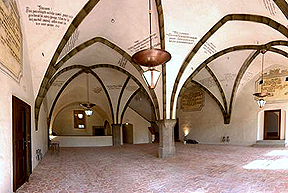
Even after extensive reconstructions, some as recent as 2006, the interior still remains connected by oddly located passageways and staircases.
However, this is part of this unusual building’s evolution and makes for a more interesting tour. I found the Great Gothic Hall, with its almost graffiti-like inscriptions on the vaulted ceiling and walls, to be the most interesting room.
Jihlava’s Musical Protégé
Jihlava is very proud that it played an important role in the formation of one of the world’s most famous conductors and composers. Gustav Mahler was just three months old when his parents moved to Jihlava on July 7,1860.
Mahler went to school here and lived with his parents at no. 4 Znojemska Street until September 10, 1875, when he went to Vienna to study at a music conservatory. The family house, which is open to the public, is now a museum dedicated to his honour.
We had a leisurely lunch in Jihlava at Restaurant Nika Atrium, one of the town’s finest eateries, before leaving on the 123-km drive back to Prague.
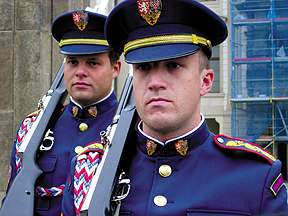
Return to Glorious Prague
On checking in at the Hotel Diplomat, we just had enough time to get ready for our walking tour of the imposing Prague Castle that dominates the skyline of any panoramic photo of the city.
The original buildings have stood on the hill overlooking Prague for at least 1000 years!
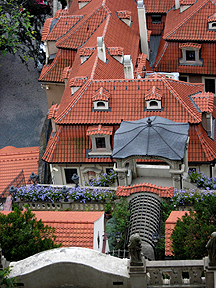
View from the Top
To cover the entire tour of the Castle, its great Gothic cathedral St. Vitus and its squares and grounds would take an entire article.
Indeed, even a half-day spent exploring this historic site would not begin to do it justice.
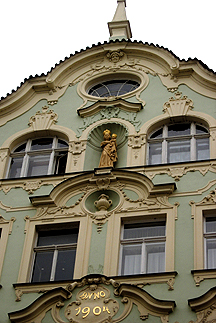 That said, I must mention the spectacular views of the city and surrounding parkland from the Castle. These alone are worth the climb.
That said, I must mention the spectacular views of the city and surrounding parkland from the Castle. These alone are worth the climb.
Restored Buildings
On the way down, we walked past lovingly restored residential and commercial buildings representing all of the periods of Prague’s long and glorious history. The steeply inclined street we descended on foot is called Nerudova. It is the main artery of Prague’s charming ‘Mala Strana’ or ‘Little Quarter’.
Our leisurely evening stroll took us down to the Vltava River where we walked across the city’s legendary Charles Bridge. It was undergoing extensive restoration at the time of our visit but was nevertheless still quite grand.
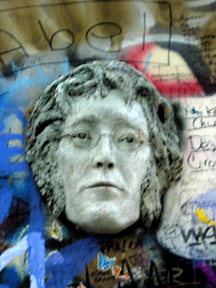 John Lives On In Prague
John Lives On In Prague
On the other side of the river, our evening promenade brought us to the John Lennon Wall. Since the 1980s, this ordinary wall on Velkoprevorske namesti Street, located close to the Charles Bridge, has been filled with ‘graffiti’ inspired by Lennon’s quest for world peace and harmony.
The former Communist regime tried many times to ‘erase’ it but the messages and drawings kept on reappearing!
It is said that this now-famous wall helped inspire the non-violent “Velvet Revolution” that led to the fall of Communism in the former Czechoslovakia in 1989.
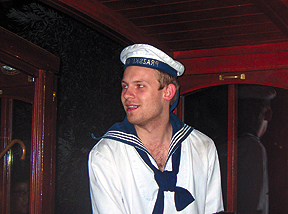
Kingly Banquet & Nighttime Cruise
After enjoying a wonderful dinner at the Restaurant U Karlova mostu, which included generous portions carved from a whole roasted pig and served under the restaurant’s vaulted brick ceiling, we boarded a small launch for a nighttime cruise on the Vltava River.
As we slid under the historic bridges that spanned the river, the running commentary and really bad jokes of our young ‘sailor’ guide and the complimentary hot and cold beverages contributed to our enjoyment of this short but interesting excursion.
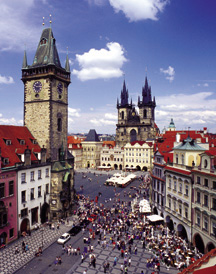
Prague’s Historic Town Square
After our river cruise, we took a romantic walk to the Old Town Square where we used the city’s highly efficient and very inexpensive metro system for the three-station ride that took us right to the front door of our hotel.
I felt proud and happy that we had seen and done so much in this exciting, historic city in just half a day. Imagine spending a whole week!
On final note on Prague. This city is super clean, safe and probably the best bargain in all of Europe. The most expensive dish on most menus is under $15.00 CAD and a glass of beer in the city’s many lively pubs and nightclubs is about $3.00.
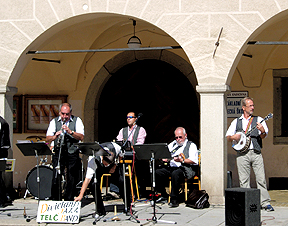
Bohemian Farewell
Before embarking on this trip, I had a fair idea about the charms of Prague but I had no idea of what to expect in the Czech Republic’s smaller cities and towns.
After this rewarding experience I can’t wait to get back to the beautiful sights, tastes and sounds of yet another Bohemian and Moravian Rhapsody!
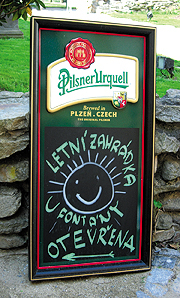
For More Info About The Czech Republic:
Czech Tourism Canada
Tel: 416-363-9928
Email: info-ca@czechtourism.com
Website: www.czechtourism.com

